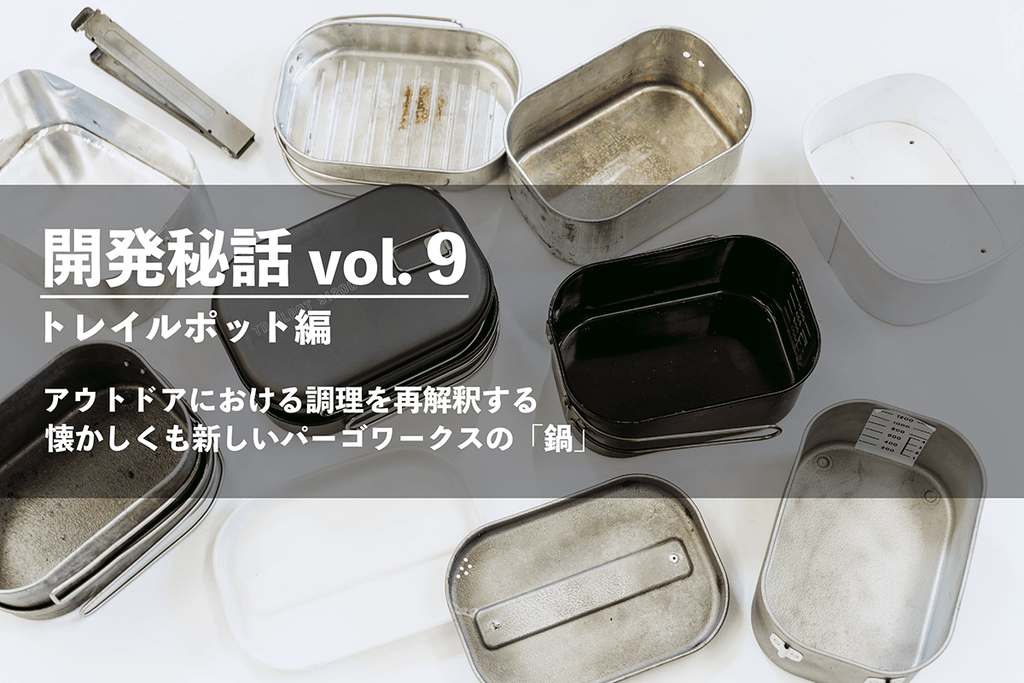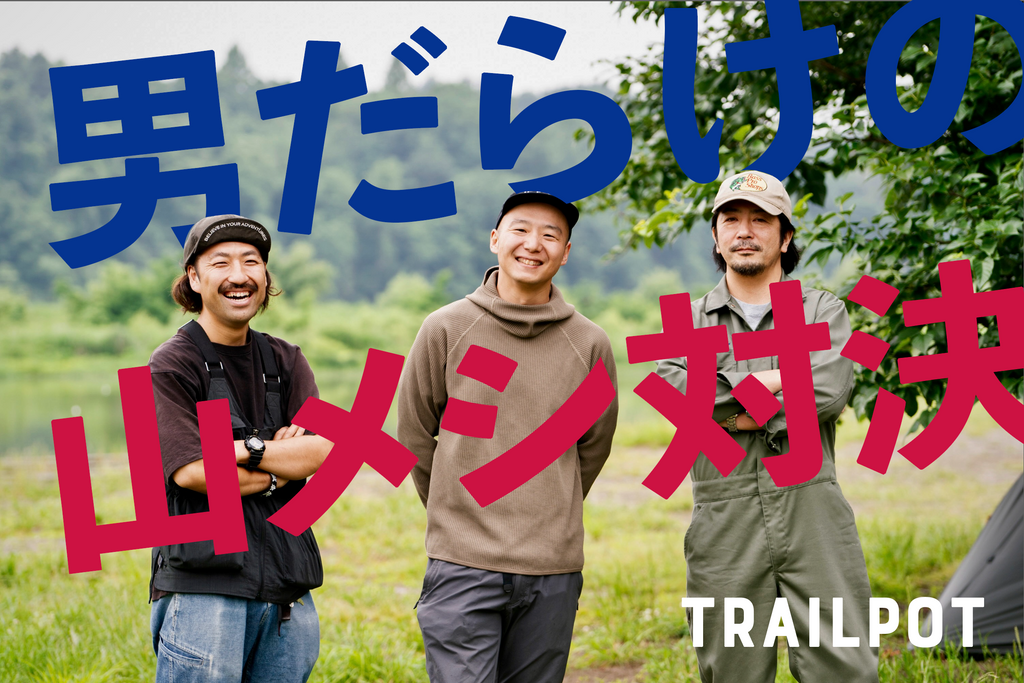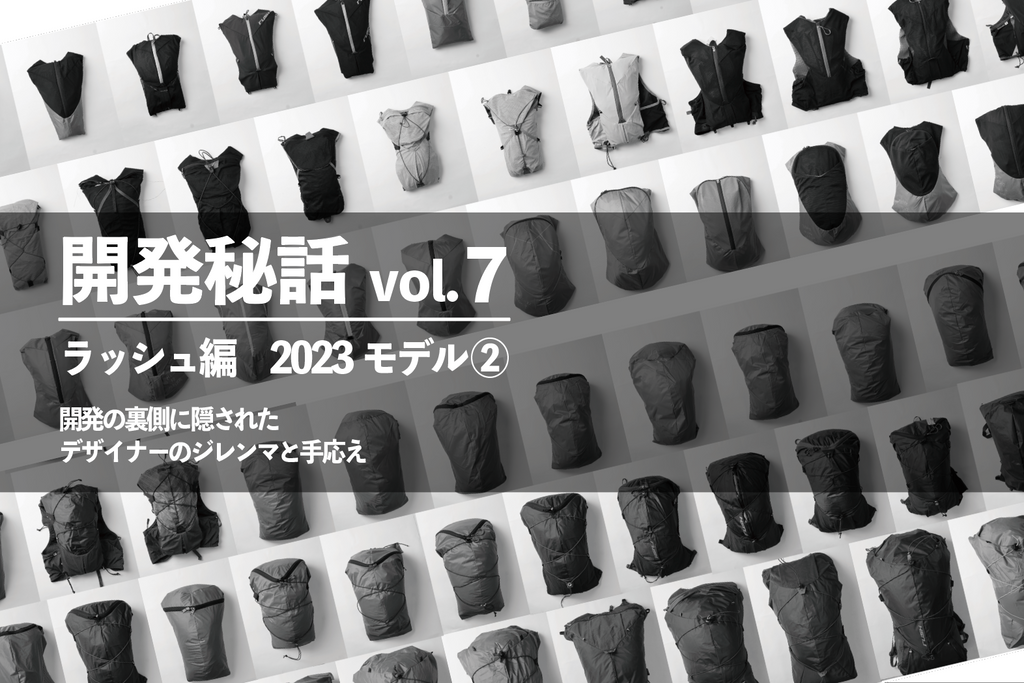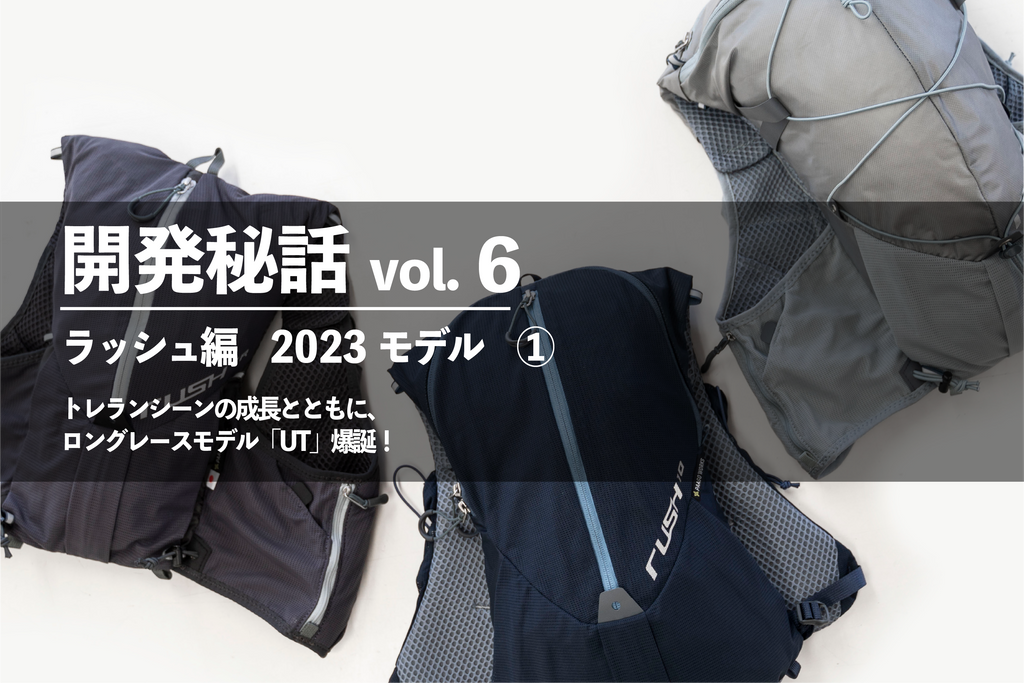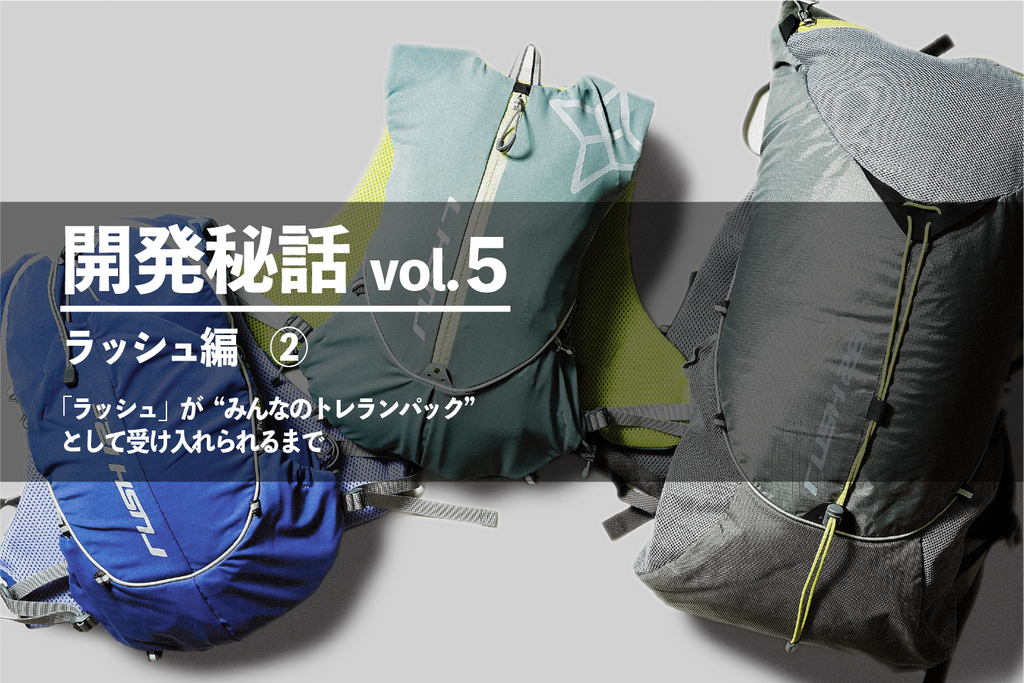MAGAZINE
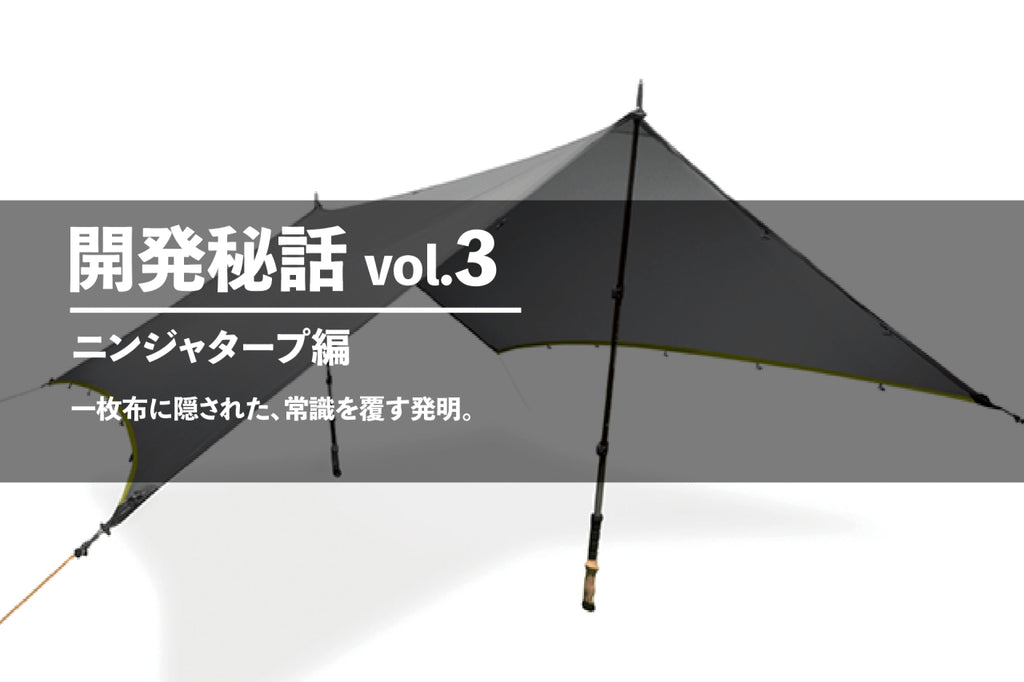
Product History Vol.3 Ninja Tarp
A groundbreaking invention hidden in a single piece of fabric
Shelter items are the foundation of Pargo Works' camping category. The starting point was the long-selling model "Ninja Tarp." The introduction of this "Ninja Tarp" enabled Pargo Works to propose a camping style.
The road to commercializing the Ninja Tarp was not an easy one. How was a product that embodies all sorts of possibilities and the freedom of the outdoors, made from just a single piece of fabric, born? Let's take a closer look.

This time, the photos were taken in a nearby park while setting up a tarp.
-Finally, in this third installment, we would like to focus on shelters. Nowadays, there are "Ninja Shelters" and "Ninja Tents," but I feel that the "Ninja Tarp" was an important product that led to our entry into the shelter category. Before we get into the development of the product itself, could you tell us why you decided to make a tarp?
The Ninja Tarp was released in 2015. The 2010s was the year when social media suddenly became popular and widespread, and it was a time when the influence of social media began to have a strong impact on mountain activities. We were in an era where we could get together with strangers and go to the mountains with friends or groups on Facebook or Instagram, saying things like, "I'm going tomorrow, how about you?" It became a casual and instant way to play.

Exhibition materials from when it was released. It was originally planned to be called "NINJA SHEET."
Up until then, it seemed like the culture was to coordinate schedules, make a proper reference plan, and make meticulous preparations before heading out, such as saying things like, "Let's go to such and such place this summer," "Make sure you have the second half of July free," "We need to buy shoes for that," and "Do you have a pot?", borrowing and lending equipment, or sharing equipment and bringing it with you on the day. Even now, of course, it depends on the type of activity, but it is now possible to skip those intermediate steps and go straight in and say, "Let's go to such and such mountain tomorrow."
So, I think that the reason why such light-footed outdoor activities became possible is mainly due to the weight reduction of equipment and personal equipment. Just in the 2010s, the UL trend came in big time, and the idea of base weight also spread, and each person was able to properly recognize their personal equipment. Before that, I think people were vague about the volume of their equipment, like 35L for mountain huts and 60L for traverses.
Since shared equipment has become personal equipment and people can complete outdoor activities by themselves, it has become possible to go to the mountains without any problems no matter who joins me. Although there is such ease, there is also a feeling that "something is missing". Even when we go to the mountains, everyone boils water in the Esbit in their tent and goes to sleep.
We meet at the same place and disperse there. We go to the mountains and pitch tents, but each person pitches their tent wherever they like and stays shut up. Even though there are friends around, they use social media in their tents to connect with others. We eat different meals, and if the weather is good it's fine, but if the weather is bad it's just a group of isolated people. It's kind of boring.

—It's true that keywords like "solo tent" were appearing frequently in magazines, and I think many people reconsidered their personal equipment because of UL. Before that, there was a culture of sharing equipment because it was more efficient to go to the mountains together.
That's right. As I became more solo, I started to feel like I wanted to create a place where everyone could gather. That's when I started to pay attention to tarps. I often brought them with me as a "roof for parties," but I started to think about how I could combine them better with my personal equipment.
Until then, tarps were thought of as camping equipment used at family camps, or something more niche that mountain climbers would take with them. I don't think tarps are often considered a candidate for mountaineering.
However, at that time, small tarps were starting to appear under the UL brand, and I was attracted to them. They were simple products. Although they were just a single piece of fabric, they had a creative side to them, allowing them to be used in a variety of ways depending on your experience, skills, and ideas. That made them an attractive subject for design. So I started developing them.
—The key words would be that it can be used in any situation, is personal equipment, but can also be a place where everyone can gather.
That's right. But before thinking about the design and functionality of the tarp itself, I had a vague idea that it would be nice to expand the space by connecting each tarp. If everyone brings their own tarp, there will be enough space for everyone, and it won't be a problem if one person cancels at the last minute. Even though it's personal equipment, you can create space according to the number of people. As I mentioned earlier, even though each one is together, it doesn't feel scattered. So I guess the initial idea was "I want to connect them."

Test the connection with the prototype.
—Once you had a theme in mind, how did you go about developing it specifically?
The first thing I thought of was a hexagon. Many camping tarps are hexagonal, but I noticed that when you connect two tarps together, they can be connected like a soccer ball. It might be a bit of an architectural idea. I thought about adding a zipper so that they could be connected. But when I tested it at full size, it was very difficult to use. Anyway, it takes a lot of brainpower to set it up (laughs).
If you add a zipper or buckle to connect the rope, it ends up being heavy, and it's fun to see how many different ways you can connect the rope, but it's very difficult to set up. No one will take it, and I don't think I'd take it either.

The Ninja Tarp can be easily set up by first pegging down the four corners and then inserting the poles.
So, I decided to first make sure it was easy to set up, and then think about how to connect them. The simplest shape is a square, but if it's a hexagon, you can set it up like a one-pole tent. Just pull down the four corners and set up the poles.
The general procedure for setting up a tarp is to first spread the tarp, then drive in two pegs at each end to match the positions of the poles, stretch the guy lines and set up the poles. As you set up the tarp, adjust the guy lines and apply tension to finish. This is probably the standard way to set up a tarp. But doing this process alone is difficult.
So I took inspiration from a one-pole tent. I wondered if I could somehow incorporate the speed and ease of setup of a tent, which is achieved by first pegging down the four corners and then setting up the center pole. And so I arrived at the shuriken type. With the shuriken type, you also peg down the four corners first, set up the pole, and then it will stand up just by applying tension.

Guy points are provided on the inside to make it easy to tension.
One feature of the shuriken type is that the tension is applied to the inside, so there is no need for guy lines on the outside of the pole. This is impossible with the square type. This is because even if you peg down the four corners and lift them up, the pole will fall inward, so you need external lines to pull it outward. In the early stages of development, we prioritized connecting the poles, so the base shape was a hexagon, which made it difficult to set up, but this solved the problem of ease of setting up.
Tarps are generally shaped like a square or hexagon. So when I came up with the idea for the shuriken-shaped "Ninja Tarp," I thought, "I'm a genius!" (laughs) I almost wish all tarps in the world were this shape.


Simulating the shape using a miniature model.
—It's truly an invention. I think this structure couldn't have been possible with any other tarp shape up until now. But how did you come up with the shuriken shape?
Rather than using my hands, I arrived at the idea while picturing it in my head. There is a ground, a ceiling, and two poles. In order to prevent these poles from tipping inwards, an outward force is needed, and usually this is handled with guylines, but I had the image in my head that if I made it into a shuriken shape...
This seems like it will work! So I made a full-sized prototype and set it up on the riverbank, but the next step was to work on the drawstring, which is a very innovative feature for a tarp. Once the shape was decided, I realized that I could do a lot by tightening the sides. I originally wanted to do something about the tendency for it to sag, so I thought about tightening it with string, but by applying tension, it becomes three-dimensional. And then I made another discovery. I was able to move the pole position freely. If it's on the inside, it's OK anywhere. As long as the four corners are firmly secured, it works in the middle, diagonally, or anywhere. So I attached the pole and set up loops in places that would be easy to use, and tried various ways to set it up. It was easy to do any of them, and the problem of how easy it was to set up was easily solved.


The next step is to work on the drawstring, which is a fairly innovative feature for a tarp. Once the shape was decided, I realized that I could do a lot by tightening the sides. I originally wanted to do something about the tarp's tendency to sag, so I thought about tightening it with a string, but by applying tension, it becomes three-dimensional.
Tarps are great because they are open, but there are times when you want to close them up. It's easier to use if they're closed up in the sun, rain, or when you're staying overnight. If you can tighten the tarp with a single pull of the drawstring in those situations, I thought you could do a lot of different things.


—How did you solve your original idea of "linking"?
We tried a variety of methods for this too: buckles, velcro, zippers, strings, grommets, buttons, etc. We tested them all, and in the end, the toggle was the one that remained.
Toggles are a really primitive mechanism. They are a simple method of just hooking parts onto a ring, and are the most primitive of all the connection methods, so much so that the Eskimos used them. There is the problem of gaps when they are connected, but since it is a tarp in the first place, I thought, "Rain and wind will get in, but on the other hand, isn't it better for the wind to pass through?" I thought it was fine. Even if you have a bonfire underneath, the smoke will escape, so it's fine, right? (laughs)
Of course, some people might say, "It would be better to make it tighter with a zipper," or "You can just fasten it with Velcro," but I came to the conclusion that the best way to connect them was with a toggle.
The toggles are spaced 47cm apart, and can be connected infinitely if they are stretched flat. However, in reality, I think two pieces are more convenient. Of course, I have done it with four pieces, but it is quite spacious. The product itself was made to the size of a personal equipment, so the original goal of creating a large space when two people bring it together was achieved.


--The name "NINJA" is quite impactful, but what was the background behind the naming?
The Pargo Works logo is a shuriken, and the shape of the tarp also resembles a shuriken, so the original idea was to call it the "Shuriken Tarp." However, since we wanted to sell it in the US as well, we decided on the catchier word "Ninja."
It's not interesting if we just use the name Ninja, so at Off The Grid (an outdoor exhibition also organized by Pargo Works), I dressed up as a ninja and demonstrated how to set up the tent. I'm sure the people who came remember it, but it was so exciting that it drew a crowd. I also did this ninja show in America, and it was well received. I think it made an impact (laughs).
The Ninja Tarp is easy to set up and can be used in a variety of ways, but it is still just a single piece of fabric. That's why the key was to communicate how versatile it can be and make people think it's interesting.
I think that both customers and store staff had the image that Pargo Works was a bag brand, but we were able to defy their expectations in a good way. The 300 bags we had prepared for the first event were sold out in one day, so we had a better response than we expected.


The name "Ninja" has been well-received at events overseas. PCT days 2019
—Is the production method also different from previous backpacks?
Tarps can't be made in backpack factories. So we started from scratch looking for a factory. Of course, there were many twists and turns. At first, we produced them at a factory that was introduced to us, but in fact, for the first year or so, we had almost no sales profit. This was because the cost price was so high.
However, after looking at various factories, we were able to place an order with a first-class factory in Taiwan. The cost became reasonable, and more than anything, the level of sewing was much higher, so the quality also improved. It was also a production factory for a major European or American manufacturer, and although Pargoworks' production volume was probably tiny in comparison, they accepted the order. This made us very happy.

Every production run is inspected at the local factory.
Generally, tarps are made of polyester or nylon. There are various types, such as thick and heavy ones and thin and light ones. The other type is coated. Generally, it is polyurethane coated, and very rarely, it is silnylon.
The Ninja Tarp uses silnylon, which is elastic and goes well with tarps. The fabric is ripstop, which is tear-resistant, and the ripstop part is made of high-density nylon called nylon 66. It's a very high-density fabric, so it's very durable.
Silicone coating has the advantage that it repels water, so it can be packed quickly and dries quickly even if it gets wet. It also does not hydrolyze like polyurethane, so it is easy to use. However, it is slippery, so it is difficult to sew in the factory, so it is difficult to handle, but I am grateful that they have overcome such challenges and are accepting production.

Silnylon is difficult to sew and causes problems for factories.
—There's also a derivative item called the "Ninja Nest."
The Ninja Nest is one of my favorite Pargo products. It's light and super comfortable, so it seems to be very popular in the US. It was originally a response to a user request: "I want to sleep under a tarp, but I want a mosquito net because bugs get in." I thought Pargo shouldn't make mosquito nets because I wanted people to use other companies' mosquito nets. But if we were to make one, we wanted it to go well with the Ninja Tarp and create a proper space, so we decided to develop it.
At first it was for one person. Since it was originally a personal item, I thought it would be fine if one person could sleep in it, but when I tried making a prototype, the weight was almost the same for one person and two people. So I decided it would be better for two people. Of course, if you use it for one person, it will be a very luxurious space, and there is enough space for three people to sleep in it.
It weighs about 630g by itself. Since a tarp is naturally floorless, the Ninja Nest allows it to be used as a floor-style relaxing tent. The deep bathtub-shaped floor and wide mesh panel are designed to combine the open feeling of a tarp with the security of a tent. If you raise the front, it feels open and the wind flows through easily. On the other hand, if you close it properly, it is comfortable enough to be used even in slightly cold seasons.

Use in conjunction with NINJA NEST (inner tent).
- The Ninja Series started with the Tarp, and the ultimate option, the Nest, was added to complete the whole world. The system can now be put together, and the range of ways to play has expanded.
In that sense, the core of the project is the "Ninja Nest." The "Ninja Nest" can be used as either a "Ninja Tarp" or a "Ninja Shelter." The development started with the tarp, but with the "Ninja Nest" as the living space at the center, you can also use the "Ninja Tarp" or "Ninja Shelter" depending on the scene or purpose.
The Ninja Tarp was released in 2015, and sales have been increasing year by year. I'd like to say that the times have caught up, but I think the reason behind this is that the camping market has matured. My impression was that it was already fully mature in 2010, but there has been an increasing shift from families to the "individual," and I think that the Ninja Tarp, which is personal equipment, has attracted attention.
Speaking of the camping scene, festivals were popular in the early 2000s, and a trend was born in which people thought the outdoors was fun and camping was fun, creating a so-called cool camping style. However, as people like that get older, when they go camping with their families, they move into a style of driving a Land Cruiser, taking their children, and staying in a large tent. However, when the children get older, I think they move away from large-scale camping and towards a style that seeks individuality again.

The NINJA SHELTER, which was released last year, can also be used in combination with the NINJA NEST.
—You can't always have the same style, and your tastes change as your lifestyle changes.
So, as people became "individuals," those who used high-end camping gear started to shift to something more like their own treasures, something better even if it was a little more expensive. I wanted them to choose the "Ninja Tarp" as an option, and I think that has actually been a success.
The generation that was children during the festival will probably move towards emerging Chinese brands rather than mass foreign brands, and one of the interesting things about camping is that there are so many different layers to different generations and eras.
Also, a mature scene means you can enjoy it comfortably and safely. No matter what you choose, it's pretty fun and not dangerous. But it's times like these that make tools that are "playful," "inconvenient," and "unique" more fun. The outdoors is inconvenient to begin with, but you need creativity to make that inconvenience more comfortable, and the fun is in coming up with ways to make it. The concept of the "Ninja Tarp" is to overcome the inconvenience with imagination.
It's light and easy to carry, easy to set up, and can be linked together for everyone to enjoy. It has some UL-like features, but it can also be used in a style of play that relies on your own skills and creativity, like bushcraft. I think the Ninja Tarp is a product with great potential.


—Apart from casual camping gear, I think tarps are a pretty cutting-edge item among outdoor gear, but I feel like the Ninja Tarp has been accepted even more than that image suggests. It's easy to get started on, but also has a deep, swamp-like depth.
At a campsite, there are a lot of big foreign tents lined up, and it's like you're having a tent sauna, and next to them, the "Ninja Tarp" is creating its own little world. I think it's great that camping can have so many different ways of enjoying it, and that each person can enjoy it in their own way. But you can also learn about it by watching the different ways users use it on social media. When people use it in interesting ways, I'm really glad I made it.


NINJA TARP
This tarp is incredibly easy to pitch and has many setup variations. Its light weight and compact size expand the possibilities of tarps.
Accessories: 6 guy lines, stuff sack
Size: 2800 x 2800mm (storage size 270 x 90 x 90mm)
Unit weight: Approx. 395g
Total weight: Approx. 500g
Main material: 30D nylon with silicone coating


